PEUGEOT 5008 2015 Owners Manual
Manufacturer: PEUGEOT, Model Year: 2015, Model line: 5008, Model: PEUGEOT 5008 2015Pages: 364, PDF Size: 12.82 MB
Page 221 of 364
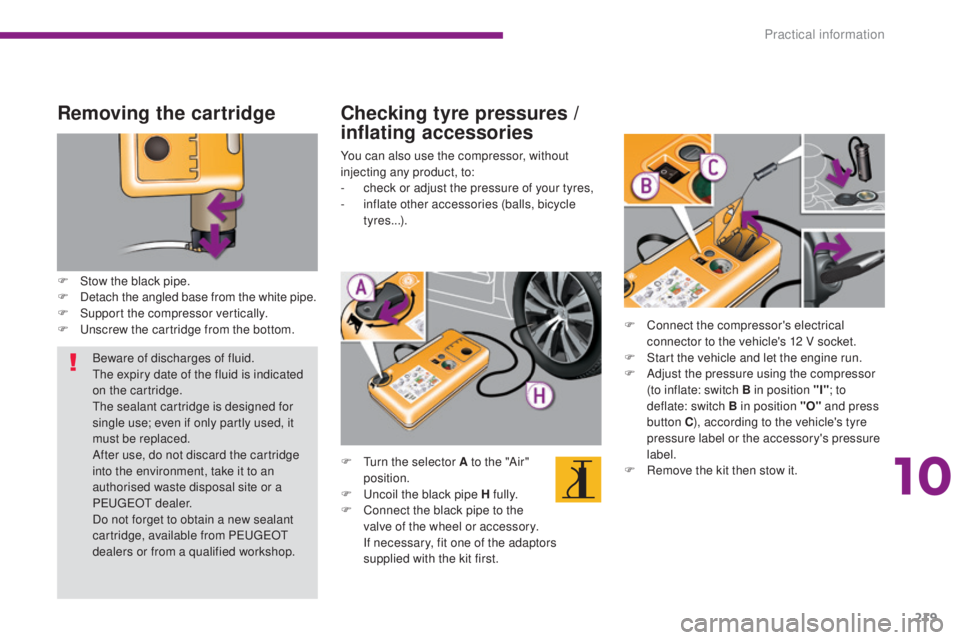
219
Removing the cartridge
F Stow the black pipe.
F D etach the angled base from the white pipe.
F
S
upport the compressor vertically.
F
U
nscrew the cartridge from the bottom.
Checking tyre pressures /
inflating accessories
You can also use the compressor, without
injecting any product, to:
-
c
heck or adjust the pressure of your tyres,
-
i
nflate other accessories (balls, bicycle
tyres...).
F
T
urn the selector A to the "Air"
position.
F
U
ncoil the black pipe H fully.
F
C
onnect the black pipe to the
valve of the wheel or accessory.
I
f necessary, fit one of the adaptors
supplied with the kit first. F
C
onnect the compressor's electrical
connector to the vehicle's 12 V socket.
F
S
tart the vehicle and let the engine run.
F
A
djust the pressure using the compressor
(to inflate: switch B in position "I" ; to
deflate: switch B in position "O" and press
button C ), according to the vehicle's tyre
pressure label or the accessory's pressure
label.
F
R
emove the kit then stow it.
Beware of discharges of fluid.
The expiry date of the fluid is indicated
on the cartridge.
The sealant cartridge is designed for
single use; even if only partly used, it
must be replaced.
After use, do not discard the cartridge
into the environment, take it to an
authorised waste disposal site or a
PEUGEOT dealer.
Do not forget to obtain a new sealant
cartridge, available from PEUGEOT
dealers or from a qualified workshop.
10
Practical information
Page 222 of 364
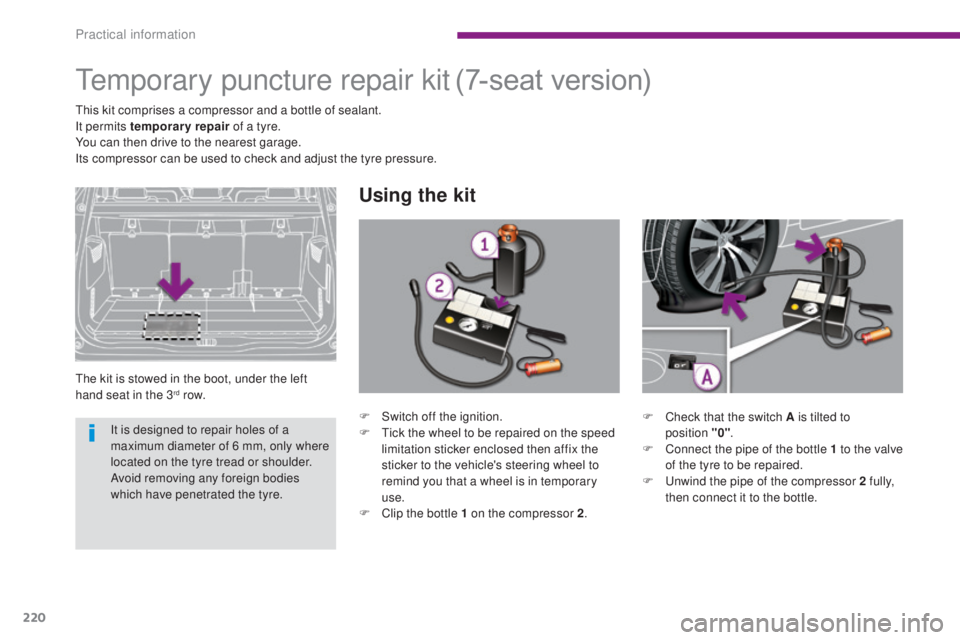
220
Temporary puncture repair kit
The kit is stowed in the boot, under the left
hand seat in the 3rd row.
Using the kit
(7-seat version)
This kit comprises a compressor and a bottle of sealant.
It permits temporary repair of a tyre.
You can then drive to the nearest garage.
Its compressor can be used to check and adjust the tyre pressure.
F
C
heck that the switch A is tilted to
position
"0".
F
C
onnect the pipe of the bottle 1 to the valve
of the tyre to be repaired.
F
U
nwind the pipe of the compressor 2 fully,
then connect it to the bottle.
F
S
witch off the ignition.
F
T
ick the wheel to be repaired on the speed
limitation sticker enclosed then affix the
sticker to the vehicle's steering wheel to
remind you that a wheel is in temporary
use.
F
C
lip the bottle 1 on the compressor 2.
It is designed to repair holes of a
maximum diameter of 6 mm, only where
located on the tyre tread or shoulder.
Avoid removing any foreign bodies
which have penetrated the tyre.
Practical information
Page 223 of 364
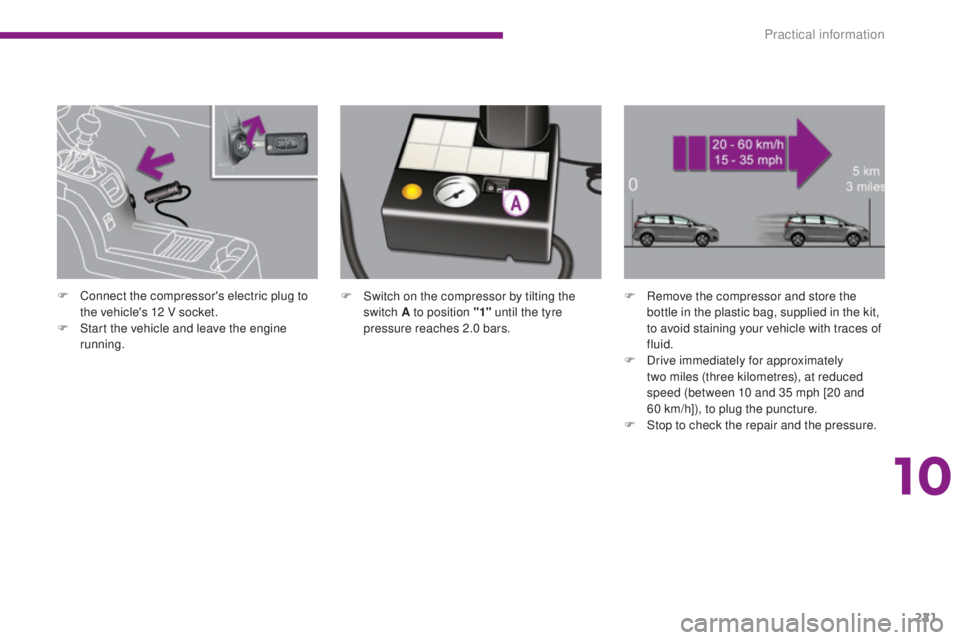
221
F Switch on the compressor by tilting the switch A to position "1" until the tyre
pressure reaches 2.0 bars. F
R emove the compressor and store the
bottle in the plastic bag, supplied in the kit,
to avoid staining your vehicle with traces of
fluid.
F
D
rive immediately for approximately
two miles (three kilometres), at reduced
speed (between 10 and 35 mph [20 and
60
km/h]), to plug the puncture.
F
S
top to check the repair and the pressure.
F
C
onnect the compressor's electric plug to
the vehicle's 12 V socket.
F
S
tart the vehicle and leave the engine
running.
10
Practical information
Page 224 of 364
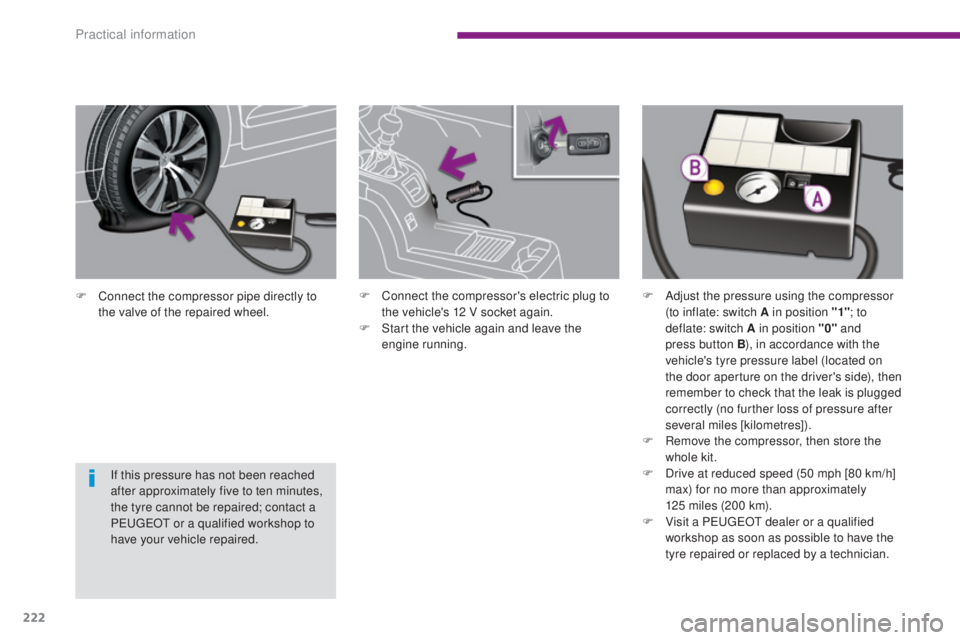
222
F Connect the compressor pipe directly to the valve of the repaired wheel.
If this pressure has not been reached
after approximately five to ten minutes,
the tyre cannot be repaired; contact a
PEUGEOT or a qualified workshop to
have your vehicle repaired. F
C onnect the compressor's electric plug to
the vehicle's 12 V socket again.
F
S
tart the vehicle again and leave the
engine running. F
A djust the pressure using the compressor
(to inflate: switch A in position "1" ; to
deflate: switch A
in position "0" and
press button B ), in accordance with the
vehicle's tyre pressure label (located on
the door aperture on the driver's side), then
remember to check that the leak is plugged
correctly (no further loss of pressure after
several miles [kilometres]).
F
R
emove the compressor, then store the
whole kit.
F
D
rive at reduced speed (50 mph [80 km/h]
max) for no more than approximately
125
miles (200 km).
F
V
isit a PEUGEOT dealer or a qualified
workshop as soon as possible to have the
tyre repaired or replaced by a technician.
Practical information
Page 225 of 364
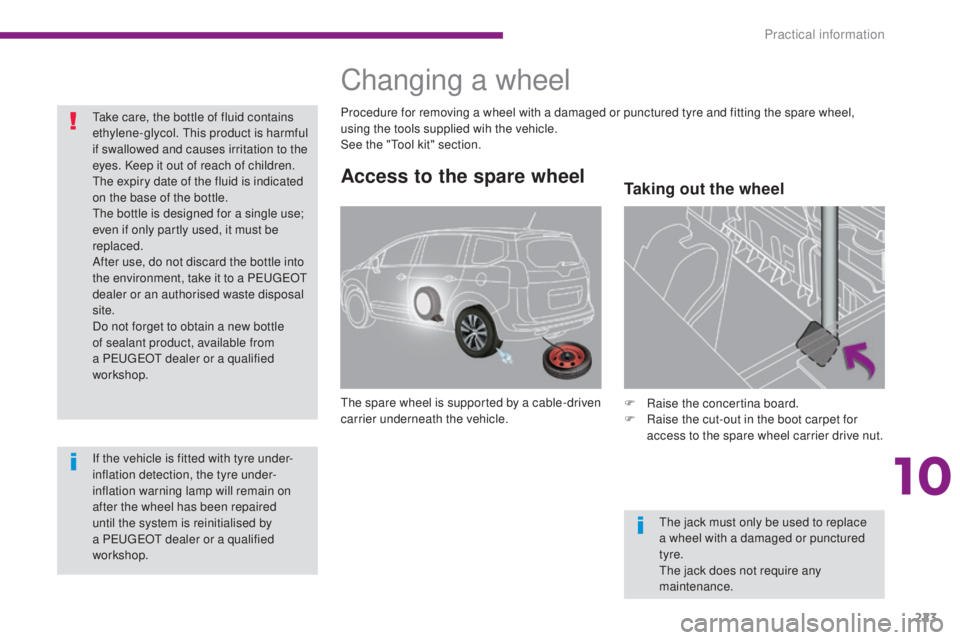
223
Access to the spare wheel
The spare wheel is supported by a cable-driven
carrier underneath the vehicle.F
Ra ise the concertina board.
F
R
aise the cut-out in the boot carpet for
access to the spare wheel carrier drive nut.
Take care, the bottle of fluid contains
ethylene-glycol. This product is harmful
if swallowed and causes irritation to the
eyes. Keep it out of reach of children.
The expiry date of the fluid is indicated
on the base of the bottle.
The bottle is designed for a single use;
even if only partly used, it must be
replaced.
After use, do not discard the bottle into
the environment, take it to a PEUGEOT
dealer or an authorised waste disposal
site.
Do not forget to obtain a new bottle
of sealant product, available from
a PEUGEOT dealer or a qualified
workshop.
If the vehicle is fitted with tyre under-
inflation detection, the tyre under-
inflation warning lamp will remain on
after the wheel has been repaired
until the system is reinitialised by
a PEUGEOT dealer or a qualified
workshop.
Changing a wheel
Procedure for removing a wheel with a damaged or punctured tyre and fitting the spare wheel,
using the tools supplied wih the vehicle.
See the "Tool kit" section.
The jack must only be used to replace
a wheel with a damaged or punctured
tyre.
The jack does not require any
maintenance.
Taking out the wheel
10
Practical information
Page 226 of 364
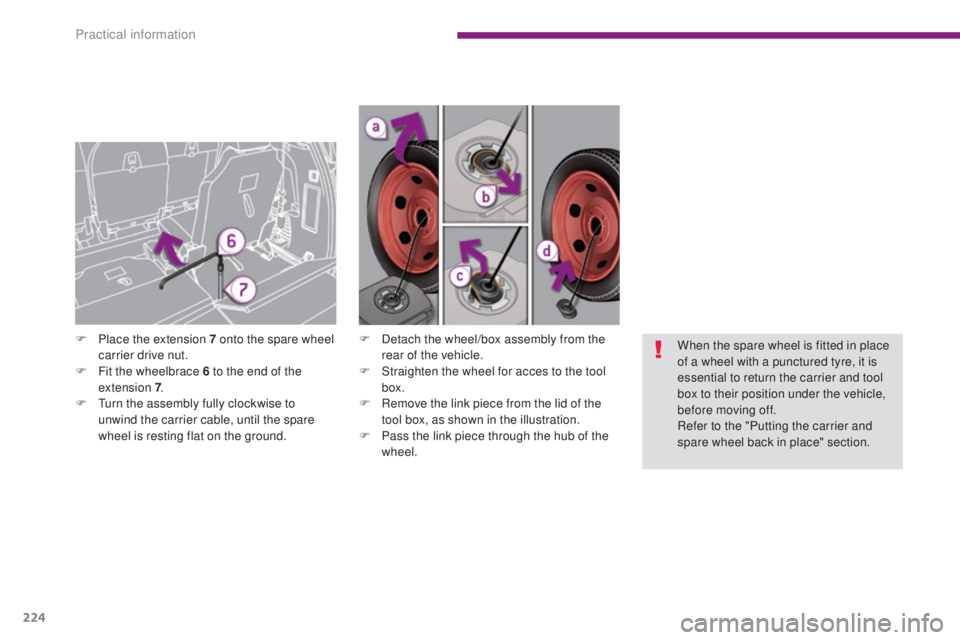
224
F Detach the wheel/box assembly from the rear of the vehicle.
F
S
traighten the wheel for acces to the tool
box.
F
R
emove the link piece from the lid of the
tool box, as shown in the illustration.
F
P
ass the link piece through the hub of the
wheel.
F
P
lace the extension 7 onto the spare wheel
carrier drive nut.
F
F
it the wheelbrace 6 to the end of the
extension 7 .
F
T
urn the assembly fully clockwise to
unwind the carrier cable, until the spare
wheel is resting flat on the ground. When the spare wheel is fitted in place
of a wheel with a punctured tyre, it is
essential to return the carrier and tool
box to their position under the vehicle,
before moving off.
Refer to the "Putting the carrier and
spare wheel back in place" section.
Practical information
Page 227 of 364
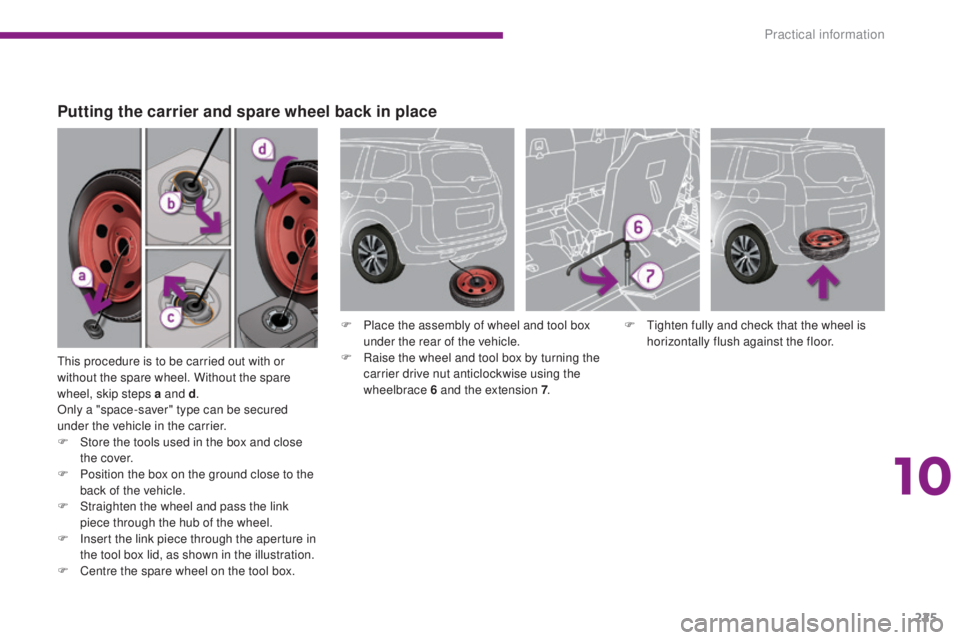
225
This procedure is to be carried out with or
without the spare wheel. Without the spare
wheel, skip steps a and d.
Only a "space-saver" type can be secured
under the vehicle in the carrier.
F
S
tore the tools used in the box and close
the cover.
F
P
osition the box on the ground close to the
back of the vehicle.
F
S
traighten the wheel and pass the link
piece through the hub of the wheel.
F
I
nsert the link piece through the aperture in
the tool box lid, as shown in the illustration.
F
C
entre the spare wheel on the tool box. F
T
ighten fully and check that the wheel is
horizontally flush against the floor.
F
P
lace the assembly of wheel and tool box
under the rear of the vehicle.
F R aise the wheel and tool box by turning the
carrier drive nut anticlockwise using the
wheelbrace 6 and the extension 7 .
Putting the carrier and spare wheel back in place
10
Practical information
Page 228 of 364
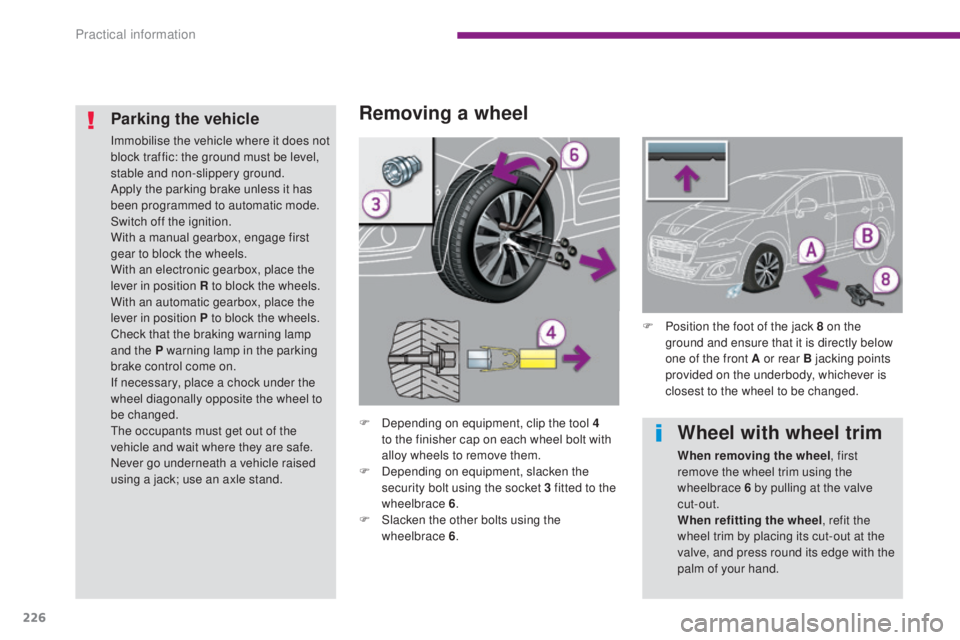
226
Removing a wheel
F Depending on equipment, clip the tool 4 to the finisher cap on each wheel bolt with
alloy wheels to remove them.
F
D
epending on equipment, slacken the
security bolt using the socket 3 fitted to the
wheelbrace 6 .
F
S
lacken the other bolts using the
wheelbrace 6 .
Parking the vehicle
Immobilise the vehicle where it does not
block traffic: the ground must be level,
stable and non-slippery ground.
Apply the parking brake unless it has
been programmed to automatic mode.
Switch off the ignition.
With a manual gearbox, engage first
gear to block the wheels.
With an electronic gearbox, place the
lever in position R to block the wheels.
With an automatic gearbox, place the
lever in position P to block the wheels.
Check that the braking warning lamp
and the P warning lamp in the parking
brake control come on.
If necessary, place a chock under the
wheel diagonally opposite the wheel to
be changed.
The occupants must get out of the
vehicle and wait where they are safe.
Never go underneath a vehicle raised
using a jack; use an axle stand. F
P
osition the foot of the jack 8 on the
ground and ensure that it is directly below
one of the front A or rear B jacking points
provided on the underbody, whichever is
closest to the wheel to be changed.
Wheel with wheel trim
When removing the wheel , first
remove the wheel trim using the
wheelbrace 6 by pulling at the valve
cut-out.
When refitting the wheel , refit the
wheel trim by placing its cut-out at the
valve, and press round its edge with the
palm of your hand.
Practical information
Page 229 of 364
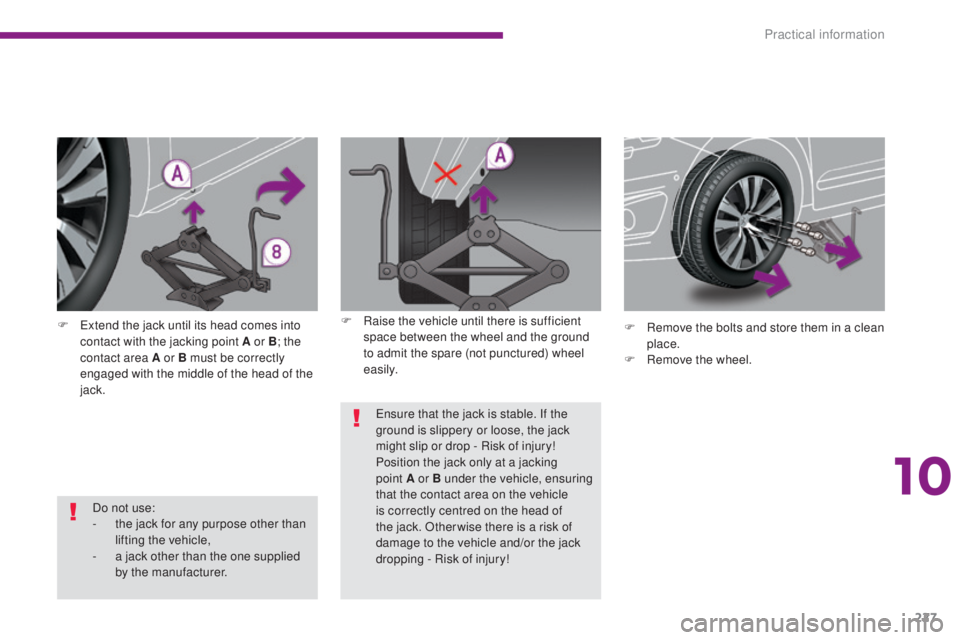
227
Do not use:
- t he jack for any purpose other than
lifting the vehicle,
-
a j
ack other than the one supplied
by the manufacturer.
F
E
xtend the jack until its head comes into
contact with the jacking point A or B ; the
contact area A or B must be correctly
engaged with the middle of the head of the
jack. F
R
emove the bolts and store them in a clean
place.
F
R
emove the wheel.
Ensure that the jack is stable. If the
ground is slippery or loose, the jack
might slip or drop - Risk of injury!
Position the jack only at a jacking
point A or B under the vehicle, ensuring
that the contact area on the vehicle
is correctly centred on the head of
the jack. Otherwise there is a risk of
damage to the vehicle and/or the jack
dropping - Risk of injury!
F
Ra
ise the vehicle until there is sufficient
space between the wheel and the ground
to admit the spare (not punctured) wheel
easily.
10
Practical information
Page 230 of 364
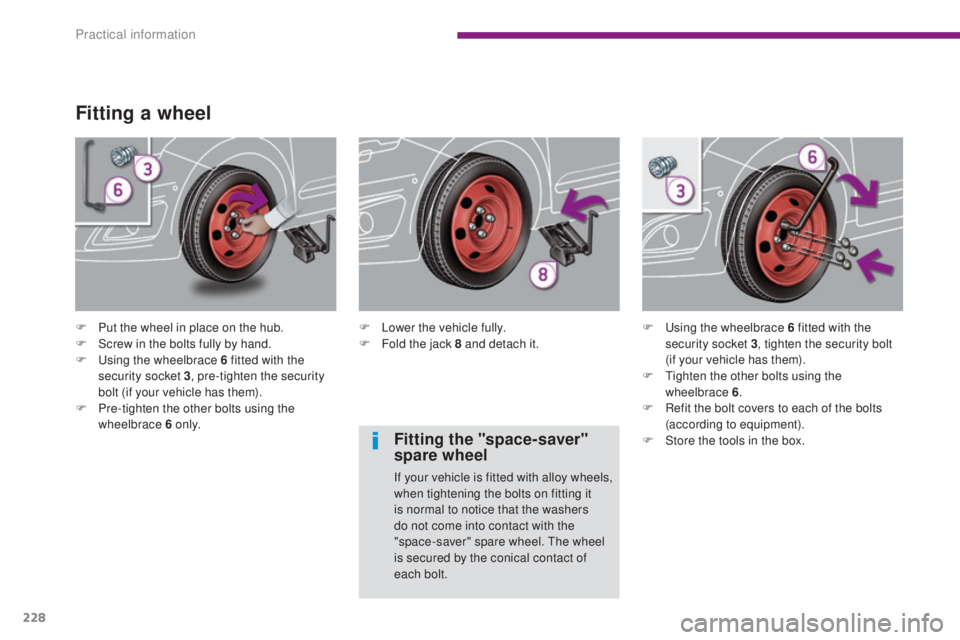
228
Fitting a wheel
F Put the wheel in place on the hub.
F S crew in the bolts fully by hand.
F
U
sing the wheelbrace 6 fitted with the
security socket 3 , pre-tighten the security
bolt (if your vehicle has them).
F
P
re-tighten the other bolts using the
wheelbrace 6 o n l y. F
L ower the vehicle fully.
F F old the jack 8 and detach it.F
U sing the wheelbrace 6 fitted with the
security socket 3 , tighten the security bolt
(if your vehicle has them).
F
T
ighten the other bolts using the
wheelbrace 6 .
F
R
efit the bolt covers to each of the bolts
(according to equipment).
F
S
tore the tools in the box.
Fitting the "space-saver"
spare wheel
If your vehicle is fitted with alloy wheels,
when tightening the bolts on fitting it
is normal to notice that the washers
do not come into contact with the
"space-saver" spare wheel. The wheel
is secured by the conical contact of
each bolt.
Practical information